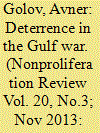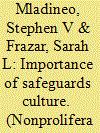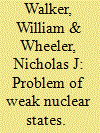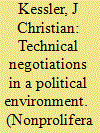|
|
|
Sort Order |
|
|
|
Items / Page
|
|
|
|
|
|
|
| Srl | Item |
| 1 |
ID:
127125


|
|
|
|
|
| Publication |
2013.
|
| Summary/Abstract |
A recently published collection of captured Iraqi records offers an opportunity to better understand Saddam Hussein's perception of US and Israeli deterrence signals, affording innovative insights into the reasons behind Iraq's restraint from using weapons of mass destruction against Israeli targets during the 1991 Gulf War. This article tests a wide range of suggested hypotheses, and suggests that US and Israeli deterrence played only a minimal role in dissuading Iraqi use of WMD. The article concludes with some thoughts on the practical implications, particularly on the effectiveness of a "no-first-use" nuclear policy.
|
|
|
|
|
|
|
|
|
|
|
|
|
|
|
|
| 2 |
ID:
127124


|
|
|
|
|
| Publication |
2013.
|
| Summary/Abstract |
Conventional wisdom states that the stability-instability paradox does not explain the effect of nuclear proliferation on the conflict propensity of South Asia, and that nuclear weapons have had a different and more dangerous impact in South Asia than Cold War Europe. I argue that the paradox explains nuclear South Asia; that the similarities between nuclear South Asia and Cold War Europe are strong; and that conventional instability does not cause revisionist challenges in the long run. I develop and probe a psychological causal mechanism that explains the impact of nuclear weapons on Cold War Europe and South Asia. Following the ten-month mobilized crisis in 2002, Pakistani President Pervez Musharraf may have adopted a more moderate foreign policy toward India after experiencing fear of imminent nuclear war, as Soviet Premier Nikita Khrushchev did forty years earlier. I argue that the stability-instability paradox explains Cold War Europe and nuclear South Asia and will, conditional on Iranian and North Korean revisionism, predict the impact of nuclear weapon development on these states' conflict propensities.
|
|
|
|
|
|
|
|
|
|
|
|
|
|
|
|
| 3 |
ID:
127129


|
|
|
|
|
| Publication |
2013.
|
| Summary/Abstract |
International safeguards is the system of measures put in place by the International Atomic Energy Agency and states to ensure nuclear programs remain dedicated to peaceful purposes. This international safeguards system consists of agreements, inspections, and evaluations that have never considered the safeguards culture of a state or facility. Neither a common definition nor an understanding of safeguards culture is internationally recognized. This article provides an analysis of the concept of safeguards culture and gauges its value to the international safeguards community. The authors explore distinctions among safeguards culture, safeguards compliance, and safeguards performance, and suggest possible indicators of safeguards culture and methods to promote a strong, positive safeguards culture.
|
|
|
|
|
|
|
|
|
|
|
|
|
|
|
|
| 4 |
ID:
127130


|
|
|
|
|
| Publication |
2013.
|
| Summary/Abstract |
Fusion reactors have the potential to be used for military purposes. This article provides quantitative estimates about weapon-relevant materials produced in future commercial fusion reactors and discusses how suitable such materials are for use in nuclear weapons. Whether states will consider such use in the future will depend on specific regulatory, political, economic, and technical boundary conditions. Based on expert interviews and the political science literature, we identify three of these conditions that could determine whether fusion power will have a military dimension in the second half of this century: first, the technological trajectory of global energy policies; second, the management of a peaceful power transition between rising and declining powers; and third, the overall acceptance of the nuclear normative order. Finally, the article discusses a few regulatory options that could be implemented by the time fusion reactors reach technological maturity and become commercially available; such research on fusion reactor safeguards should start as early as possible and accompany the current research on experimental fusion reactors.
|
|
|
|
|
|
|
|
|
|
|
|
|
|
|
|
| 5 |
ID:
127126


|
|
|
|
|
| Publication |
2013.
|
| Summary/Abstract |
Most observers would surmise that the United States applies significant pressure on certain states behind closed doors to deal with nuclear proliferation threats. While information about such pressures today remains classified, information about similar pressures in the 1970s has become available via the Freedom of Information Act. This article draws on hundreds of unpublished, declassified government documents from multiple archives to recount how the United States intervened in sensitive technology transfers to Brazil, South Korea, and Pakistan in the 1970s. In each case, US officials employed concrete sources of leverage to pressure states to cancel their nuclear arrangements. Notably, however, the United States today no longer possesses the leverage it used in the 1970s to deliver pressure. In particular, US nuclear leverage-nuclear technology, nuclear financing, and nuclear fuel-has diminished significantly over the past three decades. Policy makers in Washington therefore must ask themselves: to what extent has this loss of leverage weakened the ability of the United States to deal with nuclear proliferation threats today?
|
|
|
|
|
|
|
|
|
|
|
|
|
|
|
|
| 6 |
ID:
127123


|
|
|
|
|
| Publication |
2013.
|
| Summary/Abstract |
Governments are increasingly recognizing the problem posed by internally weak nuclear-capable states. The problem, however, is under-theorized. This article brings together literature on sovereignty and international order, the nonproliferation regime, and weak states, and introduces new concepts to provide a more structured understanding of this problem. Insight comes from focusing attention on the function and governance of two nuclear estates (termed the production and operational estates), and on their resilience to decay and disorder occurring within the state and society. Drawing on empirical observation, the authors suggest a typology of weakness in nuclear states, involving state fragmentation typified by the former Soviet Union, the "hard weak state" typified by North Korea, and the internally conflicted state typified by Pakistan. Although these types give rise to distinctive difficulties, their alleviation depends heavily on the maintenance of internal authority within the state and estates, the presence or absence of cooperative relations, and the international regulatory framework's vitality.
|
|
|
|
|
|
|
|
|
|
|
|
|
|
|
|
| 7 |
ID:
127127


|
|
|
|
|
| Publication |
2013.
|
| Summary/Abstract |
Despite a political environment fraught with core policy differences, between 1979 and 1983, six governments and two international safeguards directorates-the International Atomic Energy Agency and the Euratom Safeguards Directorate-negotiated an agreement to preserve the core verification principles behind the Treaty on the Non-Proliferation of Nuclear Weapons (NPT). At first, even agreement to talk was in doubt. Other governments questioned US motives; they wondered whether US motives in promoting the International Nuclear Fuel Cycle Evaluation had been to evaluate or to prevent non-nuclear weapon states from deploying uranium enrichment and spent fuel reprocessing technologies. In addition, Germany and Japan disagreed with the United States on whether NPT safeguards were to address undeclared materials or activities. Notwithstanding this environment, the participants reached agreement first to negotiate, and then on specific technical measures, even when the approach implied a policy consensus where none existed. At the conclusion, agreement was reached on specific technical measures for safeguards at gas centrifuge uranium enrichment plants, and all participating states, including two nuclear weapon states, made diplomatic commitments to adopt this approach for current and future centrifuge plants. This article examines the factors that facilitated agreement and considers what lessons can be learned for future efforts to solve complex technical issues in a politically charged environment and in the absence of complete agreement even on the objectives to be realized.
|
|
|
|
|
|
|
|
|
|
|
|
|
|
|
|
|
|
|
|
|